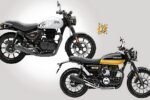When it comes to selecting a reliable, fuel-efficient, and affordable commuter motorcycle, two strong contenders in the Indian market are the Honda Shine 100 and the TVS Radeon. Both models target budget-conscious riders seeking comfort, performance, and long-term reliability. In this detailed comparison, we delve deep into every aspect of these two motorcycles to help you make an informed choice.
Contents
- 1 Design and Styling: Classic vs Practical
- 2 Engine and Performance: Smoothness vs Strong Pull
- 3 Ride Comfort and Ergonomics: Smooth Cruising
- 4 Fuel Efficiency: Mileage Champions
- 5 Features and Technology: Modern Essentials
- 6 Build Quality and Durability: Proven Reliability
- 7 Pricing and Value for Money: Affordable Excellence
- 8 Conclusion: Which One Should You Buy?
Design and Styling: Classic vs Practical
The Honda Shine 100 sticks to a clean and conservative design, aimed at appealing to a broad audience. It features sleek body lines, a chrome-accented headlamp, and a traditional stance that emphasizes practicality and simplicity. The minimalistic approach ensures that the Shine 100 remains understated yet elegant.
On the other hand, the TVS Radeon brings a bit more flair to the commuter segment. With its chromed out elements, a sturdy tank pad, textured seat cover, and unique golden-finished engine casing (in some editions), the Radeon appears slightly more premium. TVS has also added touches like DRLs (Daytime Running Lights) and a larger seat for better comfort and style.
Engine and Performance: Smoothness vs Strong Pull
Under the hood, the Honda Shine 100 is powered by a 98.98cc, single-cylinder, air-cooled engine, delivering 7.28 bhp at 7,500 rpm and 8.05 Nm of torque at 5,000 rpm. Honda’s trusted HET (Honda Eco Technology) ensures excellent fuel efficiency without compromising on basic performance. The Shine 100 engine is smooth, with a light clutch action making it ideal for daily city commuting.
The TVS Radeon, meanwhile, boasts a 109.7cc, single-cylinder, air-cooled engine, capable of producing 8.08 bhp at 7,350 rpm and 8.7 Nm of torque at 4,500 rpm. This slightly bigger engine offers better low-end torque, meaning it pulls more confidently from standstill or at low speeds — a big advantage in stop-go traffic conditions.
Verdict: If refinement and fuel economy are your top priorities, the Shine 100 edges ahead. If you seek a bit more power and low-end grunt, the Radeon makes a compelling case.
Ride Comfort and Ergonomics: Smooth Cruising
Honda Shine 100 features a softly sprung suspension setup with telescopic front forks and twin rear shock absorbers tuned for comfort. The motorcycle’s lighter kerb weight of around 99 kg makes it extremely easy to maneuver, especially for first-time riders or senior citizens.
The TVS Radeon is designed with rugged practicality in mind. Its strong frame, plush seat, and balanced suspension setup offer a planted ride even over broken roads. The motorcycle is slightly heavier at 116 kg, but this adds a certain stability at higher speeds.
Verdict: For urban commuting and frequent short rides, the Shine 100’s lightness wins. For rural roads and slightly longer daily commutes, the Radeon offers superior comfort and confidence.
Fuel Efficiency: Mileage Champions
In the budget motorcycle segment, fuel efficiency can be a deal-breaker.
The Honda Shine 100 offers an astounding claimed mileage of around 65-70 km/l, courtesy of its lightweight design and highly efficient engine tuning.
The TVS Radeon also impresses with a claimed mileage of around 65 km/l, depending on riding style and conditions. TVS’s ETFi technology (Ecothrust Fuel Injection) helps optimize fuel usage efficiently.
Verdict: Both bikes deliver stellar mileage, but the Honda Shine 100 holds a slight advantage for those who prioritize maximized fuel savings.
Features and Technology: Modern Essentials
While both motorcycles focus on the essentials, they bring different feature sets to the table:
- Honda Shine 100 features include:
- Basic analog instrument cluster
- Side-stand engine cut-off
- Combi-braking system (CBS)
- Alloy wheels
- Simple yet effective switchgear
- TVS Radeon features include:
- Stylish analog console with fuel gauge
- USB charging port (in some variants)
- Synchronized Braking Technology (SBT)
- LED DRLs
- Chrome accents for added appeal
Verdict: The TVS Radeon offers a more feature-rich package, making it appealing for those seeking modern conveniences without stretching their budget.
Build Quality and Durability: Proven Reliability
Honda motorcycles are known for their bulletproof reliability and minimal maintenance requirements. The Shine 100 is no exception, offering a robust frame, precise build quality, and long-lasting parts.
TVS, too, has built a reputation for tough, reliable products, especially suited for rough usage in semi-urban and rural areas. The Radeon’s stronger chassis and rugged construction ensure it stands up to harsh conditions.
Verdict: Both motorcycles are exceptionally durable, but the Shine 100 offers slightly better finish levels, while the Radeon scores higher on ruggedness.
Pricing and Value for Money: Affordable Excellence
- Honda Shine 100 is priced at approximately ₹64,900 (ex-showroom), making it one of the most affordable 100cc bikes in the market.
- TVS Radeon is priced slightly higher, starting at ₹73,000 (ex-showroom) for the base model and going up depending on variants.
Given the pricing, the Shine 100 represents excellent value for ultra-budget-conscious buyers, whereas the Radeon, with its premium features, justifies its slightly higher price tag.
Verdict: Choose the Honda Shine 100 if affordability is the key factor; go for the TVS Radeon if you desire a few extra comforts for a little more money.
Conclusion: Which One Should You Buy?
Choosing between the Honda Shine 100 and the TVS Radeon ultimately depends on your specific requirements:
- Buy the Honda Shine 100 if you seek unmatched fuel efficiency, refined engine performance, lightweight handling, and rock-bottom pricing.
- Buy the TVS Radeon if you prioritize slightly better performance, superior road presence, additional modern features, and rugged build quality.
Both models are strong performers in the entry-level commuter segment, and whichever you pick, you’re assured of low running costs, reliability, and a comfortable ride experience.




